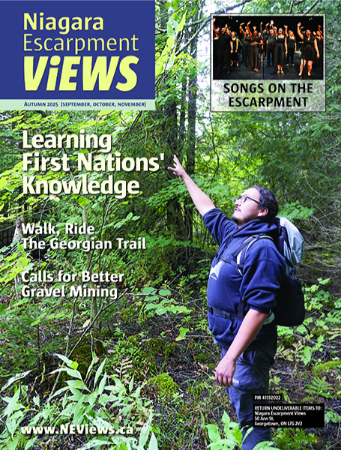The following opinion piece by Paul Glendenning of Hamilton was published on March 18 in The Hamilton Spectator. To give it a broader readership along the Escarpment, we’re posting it here. Be sure to leave your comments by clicking on the word “Comment” below.
Iroquoia Heights Conservation Area is a favourite destination for many hikers, bikers, dog walkers, nature lovers, photographers and others. It may however, turn into a killing ground with most of the deer being slaughtered in an effort to calm complaints from a few neighbours and placate hunting interests at Six Nations and the Federation of Anglers and Hunters.
Despite assurances of an open process, both the Hamilton Conservation Authority and Ministry of Natural Resources staff have already publicly recommended a cull or a “controlled” hunt. A written report by the MNR backing this recommendation is to be released soon. Local nature groups appear to be disinterested, divided, or deem the question “too political” to challenge the proposal.
According to a preliminary report, the Hamilton Conservation Authority efforts began in reaction to neighbour complaints about deer. After carrying out an aerial count of the deer in January 2009, the HCA announced a preliminary finding of 102 deer which was later raised to between 168 and 182.
According to the MNR’s Wildlife Monitoring document aerial counts are not widely used in Ontario due to the difficulty in estimating the number of deer missed. Deer typically seek cover as the helicopter approaches, making it difficult to see them from the air. Given the many areas of dense brush at Iroquoia Heights a true perspective by air would be very difficult.
Careful independent observations also contradict the official estimate and suggest a far lower population of 47-61 deer as of February 2010.
Regardless of actual numbers, the HCA and MNR experts maintain that through a generic formula of 1 deer per 6 or 7 hectares only 11 deer are allowed, to keep the population within “carrying capacity”. When carrying capacity is surpassed, deer over-browse vegetation leading to starvation and disease.
As this formula does not account for differences in habitat and with no reports of illness or starvation, it seems many more deer are capable of surviving in the park.
Despite this, an all or nothing approach has been chosen with HCA Chair Chris Firth-Eagland being quoted as saying: “The other path is to do nothing and let nature take its course — disease, starvation and more coyotes coming in to hunt the weakened deer.”
But is doing nothing really the only alternative?
The sole investigation into vegetation health is an exclosure study started by the HCA in late 2008 which fences off small parcels of land to compare to habitat affected by deer. This type of study is unlikely to produce significant results for another 4 years with debatable value. A study aimed at overall vegetation health rather than “proving” deer are causing harm would provide more relevant information.
One of the primary causes outlined by the HCA for deer “overpopulation” is food left by neighbours and visitors. Various offerings have been found along trails, in neighbouring yards as well as park edges drawing deer into nearby communities.
Public education, placing signs, and enforcement would be effective alternative actions which would actually make long-term improvements. As deer population growth is tied tightly to food availability, the population will reduce naturally if an artificial abundance is truly being sustained.
Unfenced yards have also drawn deer to residential gardens, something easily remedied through proper barriers and planting with deer in mind.
Another suggested cause has been the encapsulation of the park by residential housing and highway 403. Without the ability to leave the park it has been proposed that the population will continue to grow out of control
While it is true that no thought was given to the migration of deer by city planning, deer are resourceful and do seem to find ways in and out of the park. Possible routes include the Bruce Trail, a nearby hydro corridor and several holes in park fencing.
By building proper wildlife corridors, something recommended in the 2003 Hamilton Natural Areas Inventory, safety may be maintained without the need for mass slaughter.
So there are many things still to be done which do not include the need to kill.
Unfortunately with no concrete evidence and little talk of solving the real issues, a “stakeholder” meeting is being set up to finalise management plans. An exception to the local firearm discharge bylaw must also be granted by city council. But should special interests succeed over sustainability, there is little hope for the deer of Iroquoia Heights. And with the root concerns remaining we can look forward to killing our deer many more times in the years to come.





8 Comments
Great post – I’m currently drafting a blog on the issue of turkey hunting on Escarpment lands, and this has given me a great perspective.
I think the real threat of these deer densities has been largely ignored to the disservice of Hamilton residents.
We are not the first community in Ontario to deal with parks that have these problems. Two significant ones that come to mind are Long Point and Rondeau. The result of their inaction created two significant problems. The first, naturally, was the establishment of deer herds that exceeded their ability to sustain themselves in a healthy fashion. This weakness in the herd has permitted the establishment of the largest black legged tick populations in Ontario. Those ticks have now created a significant risk of Lyme disease in people. Studies show that 60% of Long Point ticks are now positive for Lyme disease. Source: http://www.phac-aspc.gc.ca/id-mi/tickinfo-eng.php
Lyme disease is often missed in diagnosis. While it is a relatively easy thing to treat in the first few months it can, if left untreated for too long, be permanently and cruelly disabling. If the situation that exists in Iroquois Heights is allowed to persist we will be faced with a similar health crisis in our population. That situation will spread throughout the region affecting both young and old, rural and urban.
I don’t think many Canadians are very familiar with the devastation Lyme disease can bring. Nor are they very aware that the standard testing protocol is virtually useless and misses more cases of Lyme than it finds. I think they have even less of an awareness of the risk these excessive deer populations are bringing to the community.
There is still no concrete evidence that there is a population problem at Iroquoia Heights. No illness or weakness has been observed nor any other concrete markers to indicate significant overbrowsing. Further Lyme disease which is monitored in Hamilton has not been found.
These animals are not trapped and do move in and out the park. The real challenge at Iroquoia Heights is one of improving wildlife corridors for the safety of both people and animals rather than an unsustainable population.
So while your concern might be valid regarding the misdiagnosis of Lyme Disease, I would not be too alarmed at this point as there remains no proof of an unsustainable deer population.
In fact “excessive” populations are not really possible as deer will become ill and die when their numbers overshoot their habitat. Something that has not happened at Iroquoia Heights.
As it is the tick and not the deer that carry the illness, a healthy sized deer population does not automatically mean there will be the presence of Lyme disease.
This Wednesday at 7 pm in Ancaster (see the HCA website) is the next meeting of the HCA deer commitee. It is open to the public so you may find more information of the current status of where the authorities are on the issue.
Paul,
Your assertion that it isn’t a problem is disconcerting. My wife was treated for Lyme here in Hamilton last year. It very much is in the area but certainly not as significantly as places like Rondeau and Long Point yet. Those two communities allowed their deer populations to exceed healthy densities. To further complicate the issue the current Ontario testing protocal is woefully inadequate and regularly shows a negative test when people genuinely have the disease.To react only after the disease has established a more significant foothold is too late.
I can’t imagine that you would assert that your “careful observation” would be more credible than the MNR using established scientific monitoring protocols and a helicopter.
I would agree with you that improving wildlife corridors is a good idea. Maintaining healthy densities is also a good idea.
Long Point and Rondeau had the exact same problem with deer densities. The deer did not die back to sustainable levels as you want us to believe. Those areas now have both the highest density of deer ticks as well as Long Point has a 60% infection rate for Lyme disease within those ticks. Your assertion is not empirically supportable. In fact the opposite has been seen to happen in Ontario on more than one occasion and in more than one location.
The deer may not be trapped but they are very territorial. They will not venture much outside their home range. Clearly this is their home range.
While it is true that it is the deer tick and not the deer that carry the disease, areas like Long Point and Rondeau that have allowed the deer densities to reach unhealthy levels all have deer tick and Lyme disease problems.
Lyme disease is a huge threat. It can cause so much damage if the diagnosis is missed you could require a service dog to make your life manageable. I know of at least one person that has one for that reason.
It is very unfortunate that your wife aquired lyme disease and do hope it was cought early enough. This unfortunate incident alone does not prove there is a significant threat of the disease in Hamilton nor that deer need to be killed.
My careful observations were over three month span the beginning of this year and is corroborated by those of many regular park users. I also studied all available reports and asked questions from from HCA staff and so is far deeper than a quick helicopter ride over a year and a half ago.
There is a complete lack of physical evidence to back the claim of over population and even the MNR biologist admits that it reflects only that instance in time and the deer do move but they did not study how.
This study among many other things are essential before anyone can claim there is an issue. This is further muddied by the reccomendation by the MNR to open all local green spaces to recreational hunting giving their view a very different angle.
Deer are territorial but not in the same sense that many predators are and move at least twice a year.Young males in particular disperse in search of unrelated territories which prevents inbreeding. We also cannot see just how much space the deer consider their territory. Further, as the study was done in winter, this is when deer congregate the most due to limited resources, breeding etc. and will be found in the largest numbers which do not necessarilly reflect the normal resident population.
Lyme disease will be a threat as long as there are organisms that will carry it and infect others. This does not mean we should slaughter 3/4 of a population on the pretext that some day some time in some manner an animal might come in contact with an infected insect and then carry said insect close enough to threaten a person.
Every park has it’s own strengths and challenges and therefore it cannot be assumed that what happens in one location will inevitably happen in another. Further I again say Hamilton Health says it is not a threat currently in the Hamilton area and so while increased awareness of this disease is needed (I believe the Hamilton Naturalists Club had an seminar on Lyme disease late last year/early this year) overreaction will not help anything. If you have scientific proof the disease is in the park now, be sure to let the Conservation Authority know but currently this has not been found to be the case.
The deer here need to be studied extensively, along with the ecology of the park itself (which is already messed up due to past agricultural land use), for a minimum of 5 years to acquire more representative data on the deer density, its fluctuations and associated impacts (both negative and positive). Until that study is done, drastic decisions such as a deer cull should not even be on the table. However, I do not have an issue with Natives hunting a few deer. From my understanding they have been doing so until the HCA concluded their DMAC meetings in 2011, where hunting would stop for the 3 years of monitoring. Now, if hunts occurred before this decision was made by the HCA to stop hunting, would this not potentially influence the results? I would assume more deer may be seen during monitoring since the 5 – 15 that would of otherwise been removed would still be present.
A wildlife corridor created for white-tailed deer would not just benefit deer, but also motorists, foxes, raccoons, birds, and other wildlife that cross the 403. There are many scientific journals that emphasis the importance of connectivity, especially in preserving genetic diversity. I really hope the City of Hamilton connects their conservation areas to other green spaces, specifically larger protected green space to smaller ones – SLASS (Single Large and Single Small).
Thanks for your comment, Molly. For anyone wanting to ask a question or give a comment about this issue, you can call Steve Miazga at Hamilton Conservation Authority, 905 525 2181 ext 110.
So there will be hunting in the Dundas Valley again this year – and Six Nations wants more time because last year they only managed to gun down 31 of their quota of 40. I challenge anyone from the HCA or the public to provide valid, verifiable PROOF that there is an over-population of deer. An idea that comes to mind is to conduct a “deer count” along the lines of the widely-popular Christmas Bird Count. In the weeks prior to the hunt members of the public can gather to conduct co-ordinated searches of the areas that will be hunted to see how many deer are really present. Concerned members of the public also need to make this issue known more widely – if the Natives believe that they have a right to hunt on public property near urban areas based on a 300 year-old treaty, it’s a national – if not international – issue, and attention needs to be drawn on those levels to the injustices that they are perpetrating. What kind of country do we live in when the police are being tasked with protecting their exclusive & illegal? Are we not free people in a free society – do we not have the right to protect be stewards of our land?